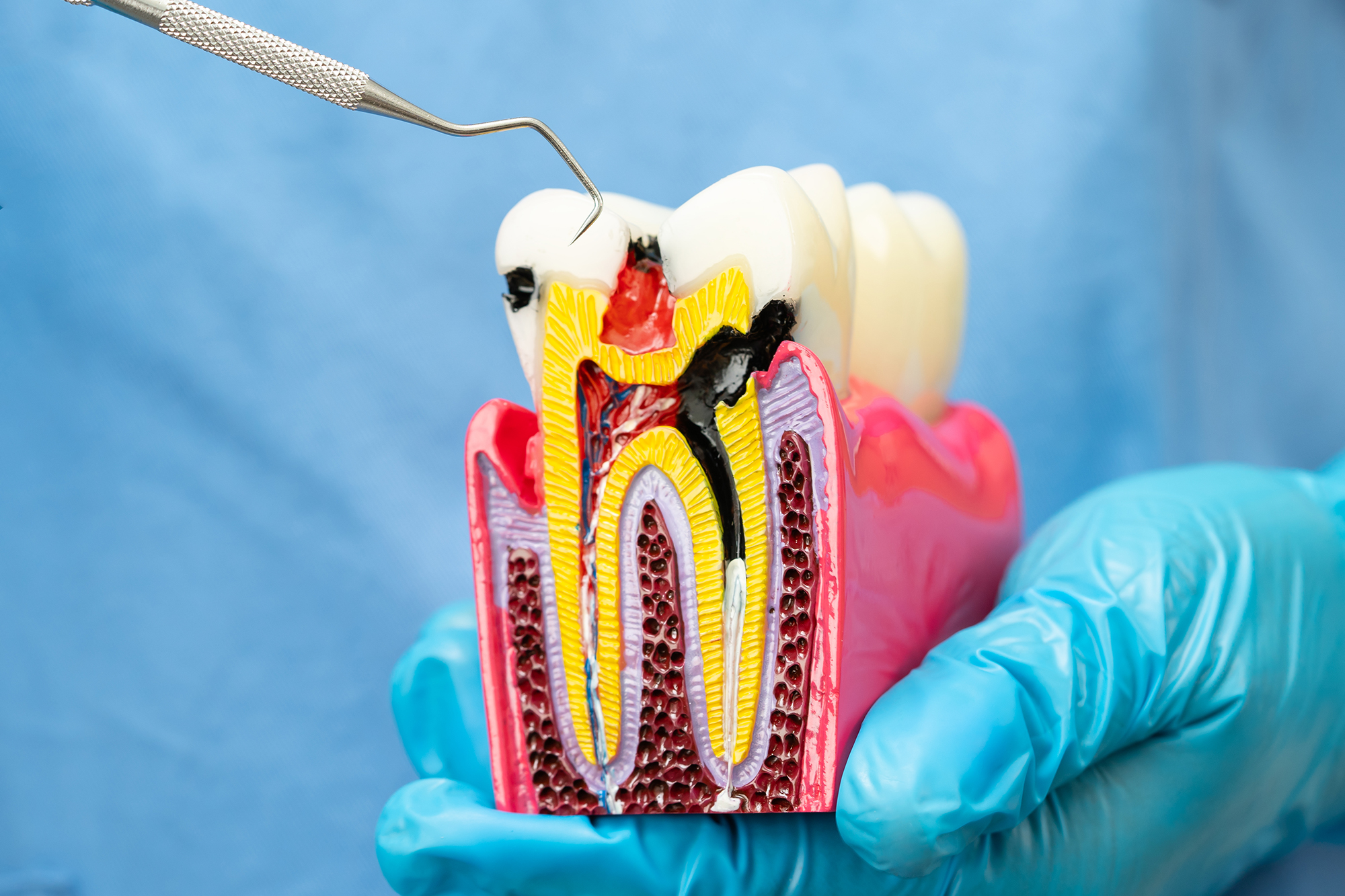
18 Jun Root Canal
Freedom From Toothache: How a Root Canal Restores Health, Happiness, and Hope

Fixing a tooth with advanced decay or infection no longer means losing it. Thanks to modern endodontic therapy—better known as a root canal—countless smiles in Central Florida have been rescued from extraction, and lives have been freed from the constant throb of dental pain. If you have been searching for a compassionate Apopka Dentist to help you reclaim comfort, function, and confidence, this detailed guide walks you through every stage of treatment, demystifies how long each step takes, and celebrates the glorious moment when pain finally stops ruling your day.
Understanding Why a Root Canal Is Needed
Inside every tooth lies a slender chamber that houses the pulp: a matrix of nerves, blood vessels, and connective tissue responsible for early tooth development. When deep decay, fractures, or repeated procedures breach the outer enamel and dentin, bacteria can infiltrate this pulp, leading to inflammation (pulpitis) and eventually infection. The resulting pressure builds within the rigid walls of the tooth, triggering the signature pulsing ache that radiates to the jaw, ear, and temple. Left untreated, the infection can travel beyond the root tip into the surrounding bone, forming an abscess and even threatening systemic health. A root canal removes the diseased tissue, disinfects the internal space, and seals the canals so the tooth can keep doing its job for decades.
First Contact: The Emergency Call
For many, the process starts with a desperate phone call to their Apopka Dentist after days of escalating discomfort. Most community‑focused practices reserve same‑day or next‑day emergency slots precisely for root‑canal‑worthy toothaches. Expect that initial triage appointment to last about 30 to 45 minutes. During this visit, the dentist or endodontist will listen to your symptoms, capture digital X‑rays, perform thermal or percussion tests, and confirm whether endodontic therapy is the best solution. If swelling is severe, you may receive an antibiotic and schedule definitive treatment a few days later; otherwise, many offices proceed on the spot.
The Anatomy of a Root Canal Visit
Contrary to internet lore, a root canal does not take all afternoon. Thanks to rotary nickel‑titanium files, apex locators, and cone‑beam CT imaging, most single‑rooted teeth (incisors, canines, many premolars) are cleaned, shaped, and filled in about 60 to 75 minutes. Molars, with their labyrinth of three to four canals, still finish in 90 minutes to two hours. Complicated cases—s‑curved roots, calcified canals, or re‑treatments—may be spread over two shorter appointments, but the great majority are single‑visit procedures.
Step‑by‑Step Timeline Inside the Chair
-
Local anesthesia (5–10 minutes). A gentle warmth spreads as lidocaine takes effect, shutting down pain signals before they start.
-
Rubber dam placement (2 minutes). A thin sheet isolates the tooth, keeping saliva out and disinfectant in.
-
Access opening (5–10 minutes). A small portal is drilled through the biting surface or the back of the tooth.
-
Cleaning & shaping (20–60 minutes). Rotary files remove pulp, sculpt canal walls, and irrigate away bacteria.
-
Disinfection & drying (5 minutes). Sodium hypochlorite or chlorhexidine soaks, followed by sterile paper points.
-
Obturation (5–10 minutes). Warm gutta‑percha and a bioceramic sealer fill the space, blocking future infection.
-
Temporary filling (2–3 minutes). A quick‑set restoration seals the access until your crown appointment.
From start to finish, you spend most of the session reclined, listening to music or watching a ceiling‑mounted TV while the team works quietly.
Post‑Treatment: From Throbbing to Thriving
The most dramatic transformation often strikes on the car ride home. Patients who arrived gripping their jaw frequently report that the “heartbeat” in their tooth is gone, replaced by a dull, manageable tenderness that fades over 24–48 hours. Over‑the‑counter ibuprofen or acetaminophen usually handles any residual soreness. Because the infection source has been removed, swelling subsides, sleep returns, and meals regain their joy. One thankful patient told his Apopka Dentist that the moment the anesthesia wore off, he felt “like my face isn’t hijacked by my tooth anymore.”
The Role of the Permanent Crown
While the inner canals are now sterile, the treated tooth needs external reinforcement. Posterior teeth in particular suffer heavy bite forces, and the access opening weakens internal walls. Scheduling a crown within two to four weeks is crucial. The crown appointment itself mirrors any other indirect restoration: 60–90 minutes for preparation and impressions (or digital scans), followed by a brief 20‑minute cementation visit after the lab fabricates the porcelain cap. Once bonded, the crown distributes pressure evenly, preventing fractures and sealing out future bacteria.
Why Modern Root Canals Feel Better Than Their Reputation
Stories of agony typically stem from pre‑anesthetic days or from infections so severe that numbing the nerve was difficult. Today, buffered anesthetics, on‑site 3‑D imaging, and nickel‑titanium instrumentation have turned the procedure into something routine. Surveys from the American Association of Endodontists repeatedly show that patients describe a root canal as no more uncomfortable than getting a filling. In fact, because the procedure removes pain’s origin, many call it the most relieving dental visit of their lives.
Measuring the Psychological Payoff
Chronic tooth pain infiltrates every corner of life: concentration at work, patience with children, even the pleasure of tasting food. When the ache lifts, energy rebounds. Patients often report sleeping through the night for the first time in weeks. They sip hot coffee without flinching, laugh without holding a cheek, and greet mornings without dread. One middle‑school teacher treated by an Apopka Dentist joked that her students noticed the difference before she did because she “smiled through the entire spelling quiz.”
Cost Versus Value
Financially, a root canal followed by a crown is still less expensive than extracting the tooth and replacing it with an implant or bridge. Typical fees in the Apopka area range from $800–$1,200 for anterior teeth and $1,000–$1,600 for molars, plus the crown. Many insurance plans classify endodontics as basic or major service, covering 50–80 %. More importantly, the investment protects your natural bite, prevents neighboring teeth from shifting, and avoids the bone loss that accompanies missing teeth.
Frequently Asked Timing Questions
- “Can I work after my appointment?” Most people resume desk work immediately, though you may prefer a half‑day to rest.
- “How long until I can eat on that side?” Wait until numbness fades (roughly two hours). Soft foods are safest for the first day.
- “What if discomfort lingers?” Mild tenderness up to a week is normal. Sharp pain beyond that warrants a check‑up; sometimes an overlooked canal needs additional cleaning.
- “Do I need antibiotics?” Not usually; the cleaning removes infection locally. Antibiotics are reserved for swelling or systemic involvement.
Life After a Successful Root Canal
Once the crown is cemented, the tooth behaves like its untouched neighbors. Routine brushing, flossing, and six‑month cleanings safeguard the seal. Treated teeth can last a lifetime, and the memory of pain fades into a motivational story you share with coworkers when they procrastinate on their own dental visits. Many patients reflect that the procedure’s greatest gift is psychological: the comforting knowledge that solutions exist, that their Apopka Dentist will not let them suffer needlessly.
Dispelling the Top Myths About Root Canals
Myth 1: “Root canals hurt.” Local anesthesia blocks pain; most patients feel only light pressure.
Myth 2: “Extraction is faster and cheaper.” Removing a tooth is quick, but replacement with a bridge or implant takes months and costs thousands.
Myth 3: “Root‑treated teeth always turn gray.” Modern bioceramic sealers and internal whitening keep teeth looking natural.
Myth 4: “The infection always comes back.” Success rates exceed 90 % when a proper crown is placed promptly.
Sedation and Comfort Options in Apopka
For especially anxious individuals, many Apopka Dentist offices offer nitrous oxide (laughing gas), oral conscious sedation, or IV sedation. Nitrous produces a floating sensation within minutes and wears off quickly, allowing you to drive yourself home. Oral sedation, taken an hour before the appointment, turns the visit into a hazy memory but requires a friend to escort you. IV sedation provides complete relaxation under the watchful eye of a dental anesthesiologist. All three options pair beautifully with local anesthesia to create a pain‑free, fear‑free experience.
A Day‑by‑Day Recovery Diary
Day 0 (Evening): Minor dull ache, easily controlled with 400 mg ibuprofen. Mild jaw stiffness from keeping your mouth open.
Day 1: Sensitivity when chewing on the tooth; stick to pasta or scrambled eggs. You notice you slept through the night.
Day 2: Tenderness fades to background. You celebrate with pizza, chewing on the opposite side.
Day 3–7: Bruise‑like feeling on deep bite test, but normal eating resumes.
Week 2: Gums look pink and healthy; you forget to pack pain relievers when you leave the house.
Week 4: Permanent crown placed—your tooth is as strong as ever.
Month 3: At your follow‑up cleaning, the hygienist can barely tell which tooth was treated.
The Community Impact of Pain‑Free Smiles
Dental pain keeps thousands of Floridians out of work and children out of school each year. When a skilled Apopka Dentist eliminates infection, the benefits ripple outward: fewer emergency‑room visits, reduced reliance on opioids, and improved academic performance. Local employers report lower absenteeism, and families regain weekend time once lost to urgent‑care visits. Choosing to treat one tooth may seem personal, but collectively these decisions strengthen the entire community’s well‑being.
A Note on Selecting an Apopka Dentist
Not all practices invest equally in technology or chairside manner. Seek a provider who offers:
- Same‑day digital X‑rays and cone‑beam CT for accurate diagnosis.
- Rotary instrumentation and electronic apex locators to shorten chair time.
- Clear financial estimates and flexible payment options.
- Calming amenities—noise‑canceling headphones, ceiling TVs, or sedation—for anxious patients.
- Genuine testimonials spotlighting compassionate care.
A quick online search for “Apopka Dentist root canal reviews” will reveal offices whose patients consistently praise painless procedures and welcoming teams.
Conclusion: From Pain to Power in a Single Afternoon
Fixing a tooth with a root canal is not the marathon ordeal it was decades ago. For most, it is a single, efficient appointment followed by a rejuvenating wave of relief. Within hours, throbbing is replaced by peace; within weeks, a crown restores full function; within months, you may forget which tooth was ever the culprit. If you’re reading this in the grip of a toothache, pick up the phone and call an Apopka Dentist today. You might still remember the rough night that prompted your appointment—but you’ll remember the sweet feeling of living pain‑free even longer.
Take the First Step Today
Bacteria inside an inflamed pulp do not wait. Each day of delay risks spreading infection to bone and bloodstream, turns a manageable root canal into possible extraction, and prolongs needless misery. Open your calendar, call a trusted Apopka Dentist, and mark the moment. In as little as one afternoon, you can trade a toothache for the simple, underrated delight of biting into a crisp apple without a second thought—and that victory is worth every minute in the chair.


